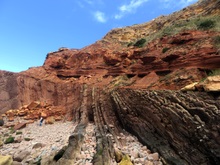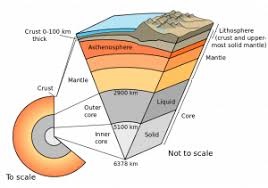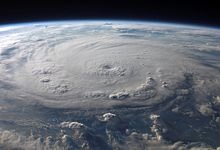Orbit and turning
Earth is part of the eight planets and many thousands of
small bodies that move around the Sun as its solar
system. The Solar System is moving through the Orion Arm
of the Milky Way galaxy now, and will be for about the
next 10,000 years.
Earth is about 150,000,000 kilometres or 93,000,000
miles away from the Sun (this distance is called an
"Astronomical Unit"). It moves on its orbit at an
average speed of about 30 km/s (19 mi/s). Earth turns
all the way around about 3651⁄4 times in the time it
takes for Earth to go all the way around the Sun. To
make up this extra bit of a day every year, an
additional day is used every four years. This is named a
"leap year".
The Moon goes around Earth at an average distance of
400,000 kilometres or 250,000 miles. It is locked to
Earth, so that it always has the same half facing Earth;
the other half is called the "dark side of the moon". It
takes about 271⁄3 days for the Moon to go all the way
around Earth, but because Earth is moving around the Sun
at the same time, it takes about 291⁄2 days for the Moon
to go from dark to bright to dark again. This is where
the word "month" came from, even though most months now
have 30 or 31 days. |
 |
| Carboniferous rocks
that were folded, uplifted and eroded during the
orogeny that completed the formation of the
Pangaea supercontinent, before deposition of the
overlying Triassic strata, in the Algarve Basin,
which marked the start of its break-up. |
History of Earth
Earth and the other planets formed about 4.6 billion
years ago. They were made of the leftover gas from the
nebula that made the Sun. The Moon may have been formed
after a collision between the early Earth and a smaller
planet (sometimes called Theia). Scientists believe that
parts of both planets broke off — becoming (by gravity)
the Moon.
Earth's water came from different places. Condensing
water vapour, and comets and asteroids hitting Earth,
made the oceans. Within a billion years (that is at
about 3.6 billion years ago) the first life evolved, in
the Archaean era. Some bacteria developed
photosynthesis, which lets plants make food from the
Sun's light and water. This released a lot of oxygen,
which was first taken up by iron in solution.
Eventually, free oxygen got into the atmosphere or air,
making Earth's surface suitable for aerobic life (see
Great Oxygenation Event). This oxygen also formed the
ozone layer which protects Earth's surface from bad
ultraviolet radiation from the Sun. Complex life on the
surface of the land did not exist before the ozone
layer.
Earth's land and climate has been very different in the
past. About 3 to 3.5 million years ago almost all land
was in one place. This is called a supercontinent. The
earliest known supercontinent was called Vaalbara. Much
later, there was a time (the Cryogenian) when Earth was
almost entirely covered by thick ice sheets (glaciers).
This is discussed as the Snowball Earth theory. |
|
 |
| Earth cutaway from
core to exosphere. Not to scale. |
What it is made of
Earth is rocky. It is the largest of the rocky planets
moving around the Sun by mass and by size. It is much
smaller than the gas giants such as Jupiter.
Chemical make-up
Overall, Earth is made of iron (32.1%), oxygen (30.1%),
silicon (15.1%), magnesium (13.9%), sulfur (2.9%),
nickel (1.8%), calcium (1.5%), and aluminium (1.4%). The
1.2% left over is made of many different kinds of other
chemicals. Chemicals that are very uncommon (such as
gold and platinum) can be very valuable.
The structure of Earth changes from the inside to the
outside. The center of earth (Earth's core) is mostly
iron (88.8%), nickel (5.8%), sulfur (4.5%), and less
than 1% other things. The Earth's crust is largely
oxygen (47%). Oxygen is normally a gas but it can join
with other chemicals to make compounds like water and
rocks. 99.22% of rocks have oxygen in them. The most
common oxygen-having rocks are silica (made with
silicon), alumina (made with aluminium), rust (made with
iron), lime (made with calcium), magnesia (made with
magnesium), potash (made with potassium), and sodium
oxide, and there are others as well.
Shape
Earth's shape is a spheroid: not quite a sphere because
it is slightly squashed on the top and bottom. The shape
is called an oblate spheroid. As Earth spins around
itself, centrifugal force forces the equator out a
little and pulls the poles in a little. The equator,
around the middle of Earth's surface, is about 40,075
kilometers or 24,900 miles long.
The highest mountain above sea level—the well-known
Mount Everest (which is 8,848 metres or 29,029 feet
above sea level)—is not actually the one that is the
farthest away from the center of the Earth. Instead, the
sleeping volcano Mount Chimborazo in Ecuador is; it is
only 6,263 metres or 20,548 feet above sea level but it
is almost at the equator. Because of this, Mount
Chimborazo is 6,384 kilometres or 3,967 miles from the
center of the Earth, while Mount Everest is 2 kilometres
or 1.2 miles closer to it. Similarly, the lowest point
below sea level that we are conscious of is the
Challenger Deep in the Mariana Trench in the Pacific
Ocean. It is about 10,971 metres or 35,994 feet below
sea level, but, again, there are probably places at the
bottom of the Arctic Ocean that are nearer to the center
of the Earth.
Earth’s core
The deepest hole ever dug is only about 12.3 kilometers
or 7.6 miles. We know something about the inside of the
Earth, though, because we can learn things from
earthquakes and the times when volcanoes erupt. We are
able to see how quickly the shock waves move through
Earth in different places.
The inside of Earth is very different from the outside.
Almost all of Earth's liquid water is in the seas or
close to the surface. The surface also has a lot of
oxygen, which comes from plants. Small and simple kinds
of life can live far under the surface, but animals and
plants only live on the surface or in the seas. The
rocks on the surface of Earth (Earth's crust) are well
known. They are thicker where there is land, between 30
to 50 km or 19 to 31 mi thick. Under the seas they are
sometimes only 6 km or 3.7 mi thick. There are three
groups of rocks that make up most of the Earth's crust.
Some rock is made when the hot liquid rock comes from
inside the earth (igneous rocks); another type of rock
is made when sediment is laid down, usually under the
sea (sedimentary rocks); and a third kind of rock is
made when the other two are changed by very high
temperature or pressure (metamorphic rocks). A very few
rocks also fall out of the sky (meteorites).
Below the crust is warm and almost-liquid rock that is
always moving around (the Earth's mantle). Then, there
is a thin liquid layer of heated rock (the outer core).
This is very hot: 7,000 °C or 13,000 °F or 7,300 K. The
middle of the inside of the Earth would be liquid as
well but all the weight of the rock above it pushes it
back into being solid. This solid middle part (the inner
core) is almost all iron. This is what makes the Earth
magnetic.
Pieces of the crust form
plates
The Earth's crust is solid but made of parts which move
very slowly. The thin level of hard rock on the outside
of the Earth rests on hot liquid material below it in
the deeper mantle. This liquid material moves because it
gets heat from the hot center of the earth. The slow
movement of the plates is what causes earthquakes,
volcanoes and large groups of mountains on the Earth.
There are three ways plates can come together. Two
plates can move towards each other ("convergent" plate
edges). This can form islands (such as Japan),
volcanoes, and high mountain ranges (such as the Andes
and Himalayas). Two plates can move away from each other
("divergent" plate edges). This gives the warm liquid
rock inside the earth a place to come out. This makes
special mountain ranges below the sea or large low lands
like Africa's Great Rift Valley. Plates are able to move
beside each other as well ("transform" plate edges, such
as the San Andreas Fault). This makes their edges crush
against each other and makes many shocks as they move.
Surface
The outside of the Earth is not even. There are high
places called mountains, and high flat places called
plateaus. There are low places called valleys and
canyons. For the most part, moving air and water from
the sky and seas damages rocks in high places and breaks
them into small pieces. The air and water then move
these pieces to lower places. Because of this, the Earth
would have been very flat a long time before now. The
fundamental cause of the differences in the Earth's
surface is plate tectonics. The shape of the entire
planet itself is not even a ball. Because of its
velocity, Earth has a slight bulge at the Equator. Other
than that, Earth is shaped more like a pear than an
actual sphere.
All places on Earth are made of, or are on top of,
rocks. The outside of the Earth is usually not uncovered
rock. Over 70% of the Earth is covered by seas full of
salty water. This salty water makes up about 971⁄2% of
all Earth's water. The fresh water people can drink is
mostly ice. Only a very small amount is in rivers and
under the Earth for people to drink and use. The air
above the Earth stops the water from going away into
outer space. Also, much of the land on Earth is covered
with plants, or with what is left from earlier living
things. Places with very little rain are dry wastes
called deserts. Deserts usually have few living things,
but life is able to grow very quickly when these wastes
have rainfall. Places with large amounts of rain may be
large woods. Lately, people have changed the environment
of the Earth a great deal. |
 |
| Hurricane Felix seen
from low Earth orbit, September 2007. |
Air
All around the Earth is a large amount of air (the
atmosphere). The mass of the Earth pulls the gasses in
the air down and does not let them go into outer space.
The air is mostly made of nitrogen (about 78%) and
oxygen (about 21%) but there are a few other gasses as
well. Most living things need the air (or parts of the
air gripped in the water) to breathe and live. They use
the gasses—especially oxygen and carbon dioxide—to make
and use sugar and to give themselves power.
The air animals and plants use to live is only the first
level of the air around the Earth (the troposphere). The
day to day changes in this level of air are named
weather; the changes between places far away from each
other and from year to year are named the climate. Rain
and storms are both in this level. Both come about
because this part of the air gets colder as it goes up.
Cold air becomes thicker and falls, and warm air becomes
thinner and goes up. The turning Earth moves the air as
well and air moves north and south because the middle of
the Earth generally gets more power from the Sun and is
warmer than the north and south points. At the same
time, air over water (specially very warm water) gets
water in it but, because cold air is not able to take in
as much water, it starts to make clouds and rain as it
gets colder. The way water moves around in a circle like
this is called the water cycle.
Above this first level, there are four other levels. The
air gets colder as it goes up in the first level; in the
second level (the stratosphere), the air gets warmer as
it goes up. This level has a special kind of oxygen
called ozone. The ozone in this air keeps living things
safe from damaging rays from the Sun. The power from
these rays is what makes this level warmer and warmer.
The middle level (the mesosphere) gets colder and colder
with height; the fourth level (the thermosphere) gets
warmer and warmer; and the last level (the exosphere) is
almost outer space and has very little air at all. It
reaches about half the way to the Moon. The three outer
levels have a lot of electric power moving through them;
this is called the ionosphere and is important for radio
and other electric waves in the air. It is also where
the Northern Lights are.
Even though air seems very light, the weight of all of
the air above the outside of the Earth (air pressure) is
important. Generally, from sea level to the top of the
outer level of the air, a space of air one cm2 across
has a mass of about 1.03 kg and a space of air one sq in
across has a weight of about 14.7 lb. The mass of the
air also keeps the Earth safe when rocks (meteorites)
hit it from outer space. Without the air, the damage
meteorites do would be much greater. Because of the air,
meteorites generally burn up long before they get to the
earth.
The air also keeps the Earth warm, specially the half
turned away from the Sun. Some gasses – especially
methane and carbon dioxide – work like a blanket to keep
things warm. In the past, the Earth has been much warmer
and much colder than it is now. Since people have grown
used to the heat we have now, though, we do not want the
Earth to be too much warmer or colder. Most of the ways
people create electric power use burning kinds of
carbon—especially coal, oil, and natural gas. Burning
these creates new carbon dioxide and can cause more
warming. A large discussion is going on now about what
people should do about the Earth's latest warming, which
has gone on for about 150 years. So far, this warming
has been good for people: plants have grown better and
the weather has been better than when it was colder
before. Some people who learn about science, though, say
that many bad things will possibly come about if the
warming goes on. |
|
People
About seven billion people live on Earth. They live in
about 200 different lands called countries. Some, for
example, Russia, are large with many large cities.
Others, for example, Vatican City, are small. The five
countries with the most people are China, India, the
United States, Indonesia, and Brazil. About 90% of
people live in the north half of the world, which has
most of the land. Scientists think that people
originally came from Africa. Now, 70% of all people do
not live in Africa but in Europe and Asia.
People change the Earth in many ways. They have been
able to grow plants for food and clothes for about ten
thousand years. When there was enough food, they were
able to build towns and cities. Near these places, men
and women were able to change rivers, bring water to
farms, and stop floods (rising water) from coming over
their land. People found useful animals and bred them so
they were easier to keep. |
|
|
|